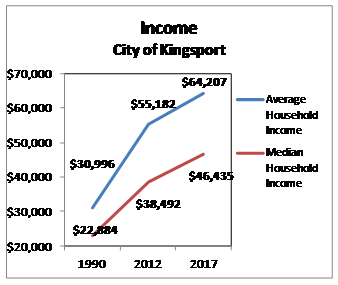15 Years Later: Kingsport Making Progress in Balancing Demographics

KINGSPORT, TN ‚¬ Amidst great change in the economic and social make-up of the community in 1999, City and community leaders established major goals including balancing the demographics, improving educational attainment, and growing income levels among Kingsport residents.
Nearly 15 years later, the Buxton Company, an international market research company, was retained to measure progress towards that goal.
There was a fundamental belief that Kingsports aging demographics would create an undesirable outcome down the road if young people werent attracted to fill the void, said Jeff Fleming, Assistant City Manager for Development.
The desire for balanced demographics and growing per capita income lead in part to the creation of the Higher Education Initiative and Academic Village, NETWORKS Sullivan Partnership, Kingsport Office of Small Business & Entrepreneurship (KOSBE) and the Move To Kingsport program.
NETWORKS in particular moved the component governments of Sullivan County from an adversarial, fragmented approach to recruiting business and manufacturing into a consolidated county-wide effort.
Innovation also continues with the recent start-up of PEAK, Professionals Engaged in Advancing Kingsport, an outreach and focal point for young professionals.
The goal was and continues to be to attract educated people with disposable income that can enhance the local economy,” Fleming explained.‚ ‚ I often say we are in search of talented people ‚¬ regardless of age.
At the time, some people incorrectly assumed we were targeting only retirees, but again, we are interested in balanced demographics. Our area is naturally attractive to retirees due to its low cost of living coupled with a high quality of life, but these factors are also attractive to people of all ages and backgrounds.”
According to the Buxton report, about 39 percent of those moving from more than 35 miles away are retirees or pre-retirees, 12.8 percent are families, 5.3 percent are single parents, and 4.8 percent are young singles.
For those moving to Kingsport from less than 35 miles away, Buxton indicated 51.3 percent are retirees/pre-retirees, 5.6 percent are single parents, 5.3 percent are young singles, and 4.8 percent are families.
These groups would be attracted by convenient medical/social services, great schools, and higher education opportunities that may not be available in nearby communities, he added.
With ongoing expansion at Eastman Chemical Company, another recent focus area has been a lack of housing types desired by young professionals.
We have already identified a shortage of housing opportunities to support professional families,” Fleming said. “Some of that is beyond our control and in the hands of developers, but were trying very hard to develop responsible and effective community strategies to ensure that professionals have housing options in Kingsport.
“While some might not see the immediate connection, a balanced demographic, which is possible only with a healthy mix of housing options, ensures steady growth. In turn, this growth broadens the overall tax base as new residential and commercial investments are made in the community.”
Overall, Fleming said it takes decades to build the balanced demographics necessary to ensure a healthy community, and Buxton’s report indicates the community is demonstrably making progress, although more work remains to be done.
We’ve made big strides in educational attainment and income growth, and some gains attracting a younger population,” Fleming said. “But it takes years of innovation, strategic investment, sustained effort and progressive leadership to attain long-term goals such as rebalancing a community’s population.”
 |
 |



